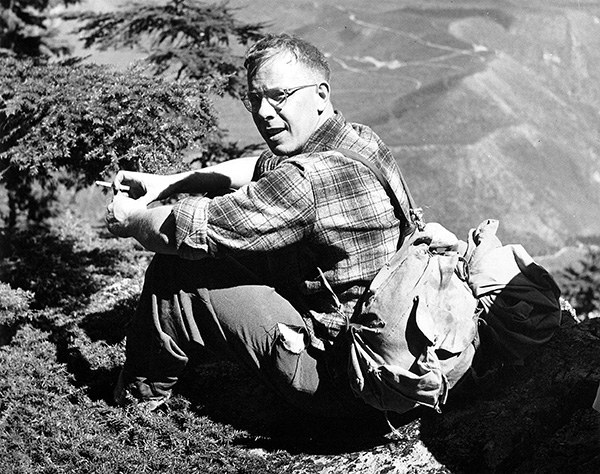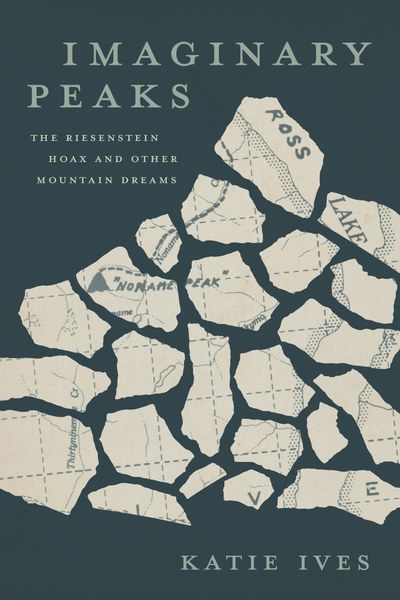
The following is excerpted from Imaginary Peaks: The Riesenstein Hoax and Other Mountain Dreams, new from Mountaineers Books.
In 1962 the editors of Summit magazine received a submission about an expedition to an unknown range of mountains, the Riesenstein peaks of British Columbia. The main summit, the mysterious author claimed, remained tantalizingly unclimbed. The editors printed the article - as if missing the clues that its creators had planted to hint that the story was a hoax (one of whom was later revealed to be Harvey Manning, editorial committee chair for the first edition of Mountaineering: The Freedom of the Hills). In Imaginary Peaks, author Katie Ives uses this literary deception about a fake mountain range as a jumping-off point to explore our shared fascination with wild places and the lure of blank spaces on the map. Read on as Ives shares her investigation into another of Harvey’s pranks, this time featuring a suspiciously high-tech sleeping bag.

To understand Harvey and his hoaxes, Dale Cole told me, people needed to understand the burgeoning outdoors industry at the cusp of the 1960s:
We saw the climbing culture itself change. New manufacturers moved into the scene and they were selling their materials for prices that we thought were cruel and high. There was another breed of climber [who] took climbing far more seriously. Not that we didn’t do serious climbing. But it wasn’t a question of bragging about it in an arrogant way.
Well, Harvey was particularly put out by this kind of climber. Especially their accounts of accomplishments in climbing journals and magazines . . . depictions that made [an ascent] more of an ego trip than a climbing trip. As you well know, climbing dates and climbing facts and bragging rights and exaggerations come up in articles submitted to climbing magazines and misrepresent what’s really there. Harvey himself said, facts and fiction read the very same way in print.
On August 1, 1959, Harvey wrote to his friend Ted Beck, detailing plans for his first (known) prank on the gear industry:
Incidentally, I’ll be calling on you shortly to take a proper part in the Great Hoax. While down at the [REI] Coop in June I picked up a copy of Summit Magazine, and the thing irritated me—especially all the pseudo-scholarly crap about sleeping bag research. So I wrote a long, circumstantial letter to the editor describing a research project being carried on by the Cougar Mountaineers, of which I, H. Hawthorne Manning, am president. . . . Dale Cole is going to follow-up with some correct and further research, as Chairman of the Sleeping System Committee.
Ideally we hope dullards from all over the country are taken in, and start criticizing the “System.” We can then answer them - having the tremendous advantage that we can invent all the necessary research and statistics while they will be dependent on fact…
Yours for mutual self-destruction,
Doctor Jekyll and Mister Hyde
While drinking homebrew, Dale and Harvey sketched out fake designs for a high-tech sleeping bag as a parody of modern gear: a tube inserted into an army surplus mask would conduct a sleeping person’s breath into a container and through a calcium-oxide filter. This chamber would, in theory, convert the moist air into heat, which another tube would then carry to “what had been determined (by Cougar Mountaineers in their research laboratories) to be the body’s temperature-control centers: the hands, the feet, and the small of the back,” Harvey explained. Layers of tightly woven wool would further insulate those vulnerable areas. Climbers and hikers could assemble the system at home at little expense, apart from the calcium oxide, which, the Cougar Mountaineers lamented, was generally produced only for “missile research.” But, they assured their readers, they were seeking a more accessible substitute for the chemical compound.
“The next day, when we’d sobered up a bit, Harvey decided we should submit this,” Dale said. Dick Brooks, a chemical engineer, added just enough of an aura of scientific research to make the hoax appear legitimate to lay readers. Summit printed it. One of the main targets of the hoax, Gerry Cunningham, had founded a Colorado-based climbing equipment company in 1946, which he’d named after himself. “Gerry Cunningham was as energetic and ingenious a builder of backpacking gear as there was,” Harvey later recounted, “and he frequently and generously shared his frontiering with readers of Summit.”
Gerry Cunningham seemed to fall for the prank immediately. For the following issue of Summit, he composed a lengthy letter to the editor attempting to debunk the “Sleeping System,” with detailed analyses of various forms of heat loss. Given a chance to respond by the Summit editors, Harvey hinted that the gear manufacturer might be wasting his energy: “The Gerry reputation speaks for itself. . . . It was highly flattering for you to devote so much time to considering our work. But, I scarcely think we have progressed to the point where we can merit your attention.” As a cautionary note, Harvey claimed that he’d seared his own lungs by accidently breathing in calcium oxide during one test. [….]
In a private note to Harvey, Ted (another chemical engineer) quipped about the science behind their hoax: “You would have a nuclear explosion if you were able to grind [calcium oxide] to that size. That would destroy Cougar MT and part of Seattle, which might be a good idea.” Dale’s subsequent Summit article blamed the hazardous dimensions of the calcium-oxide particles and the alleged lung-burning incident on the “gross errors” of the Cougar Mountaineers president. Dale also took issue with Cunningham’s reliance on convective heat loss numbers that, Dale claimed, must have been “derived from studies of a naked man. In the Northwest we find clothing a necessity. (By law if not by weather alone.)”
Heidi Brooks recalled that her father, Dick, “convulsed in laughter” when he noticed one of his colleagues had tried to work out the math of the system to the “subatomic level.” The tactics of Harvey and his friends worked, she realized, “setting people up so that their own egos would take them down.” The fabricated letters gave rise to earnest missives from backpackers unaware of the conspiracy. The hoax was becoming part of real history. And for some people, it might have stayed that way, even after Harvey described the Sleeping System as a “joke” by the “Cougar Mountaineers” in his 1972 manual, Backpacking One Step at a Time. Few climbers beyond their circle of acquaintances may have realized the identity of the chief prankster until Dale recounted the story in Harvey’s obituary. “We certainly never let on,” Dale told me decades later, still delighted at their creation.
After a few months, however, the Summit editors had decided enough was enough and stopped publishing letters about the Sleeping System. “Damn!” Harvey complained to Ted. “Well, next trip… Up the Revolution.”
Imaginary Peaks is available for pre-order or purchase at our Seattle Program Center bookstore, online at mountaineersbooks.org, and everywhere books are sold.
This article originally appeared in our Fall 2021 issue of Mountaineer Magazine. To view the original article in magazine form and read more stories from our publication, visit our magazine archive.
 Katie Ives
Katie Ives
